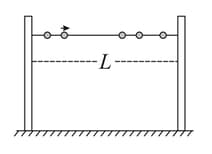A ball bounces to of its original height. What fraction of its potential energy is lost in each bounce?
Important Questions on Centre of Mass, Momentum and Collisions
Given below are two statements: one is labelled as Assertion A and the other is labelled as Reason R.
Assertion A : Body having mass moving with speed has head-on collision elastically with another body having mass initially at rest. If , body will have a maximum speed equal to after collision.
Reason R : During elastic collision, the momentum and kinetic energy are both conserved.
In the light of the above statements, choose the most appropriate answer from the options given below:
This question has and of the four choices given after the Statements, choose the one that best describes the two Statements.
A point particle of mass moving with speed collides with stationary point particle of mass . If the maximum energy loss possible is given as
then .
Maximum energy loss occurs when the particles get stuck together as a result of the collision.

A large number of identical beads, each of mass and radius are strung on a thin smooth rigid horizontal rod of length and are at rest at random positions. The rod is mounted between two rigid supports (see figure). If one of the beads is now given a speed , the average force experienced by each support after a long time is (assume all collisions are elastic):

A block of mass rests on a horizontal table. The coefficient of friction between the block and the table is . When hit by a bullet of mass moving with speed , that gets embedded in it, the block moves and comes to stop after moving a distance of on the table. If a freely falling object were to acquire speed after being dropped from height , then neglecting energy losses and taking , the value of is close to
Assertion (A): When we bounce a ball on the ground, it comes to rest after a few bounces, losing all its energy. This is an example of violation of conservation of energy.
Reason (R): Energy can change from one form to another but the total energy is always conserved.
Which of the following is true?

